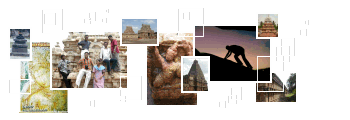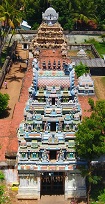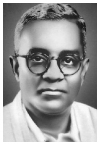 |
 |
 |
http://www.varalaaru.com A Monthly Web Magazine for South Asian History [187 Issues] [1839 Articles] |
 |
 |
 |
http://www.varalaaru.com A Monthly Web Magazine for South Asian History [187 Issues] [1839 Articles] |
|
Issue No. 138

இதழ் 138 [ அக்டோபர் 2017 ] 
இந்த இதழில்.. In this Issue.. 
|
THE ORNAMENTAL DOORFRAMES IN SRI RANGANATHA SWAMI TEMPLE, SRIRANGAM – REMNANTS OF EARLY CHOLA ARCHITECTURE
S.Sumitha
Dear Readers, I share my disappointed, discontented, horrible experience that I faced in the Tamil Nadu History Congress during the paper presentation. Myself and my two research colleagues jointly presented two research papers on Sriranganatha temple, Sri Rangam in Tamil Nadu History Congress which held on 6th to 8th October, 2017 at Alagappa University, Karaikkudi. The Art and Architecture session was chaired by Dr. Selvakumaran, Associate Professor, Department of Archeology, Tamil University. Most of the articles are by students, especially research scholars. Some are truly worthless and some shows good attempt. In the front row of the hall two elderly people, may be professors (I don't know who they are?) were there and for every article uttered some comments, not even a word of appreciation even for good efforts. When my turn came I swiftly presented the crux of the article and go to the attempt of explaining the photos that I have posted on the LCD. Finally I concluded that on the basis of inscriptions the ornamental doorframes might belong to Early Cholas. The two elderly scholars/professors commented that such feature of door ornamentation only belong to the Vijayanagar period, the ornamentation might be of later origin and in no way it can be attributed to the Early Cholas and there is no such example in Early Chola architecture. I replied that such example is seen in Pullamangai Alanduraiyar temple, their argument for this statement is 'ok, then Pullamangai could also be of later origin - the work of Vijayanagar'. Then I furthered with my next logically argument, 'the miniatures in the ringlets are specifically early elements, because the posture, ornamentations, instruments and above all the elegance in the miniatures are purely early element'. So what? kodikarukku ornamentation belongs only to the Vijayanagar, we have seen only in the Vijayanagar architecture, nobody can change this theory. They were not ready to accept this argument as they weighed me in stature and attire, how possible for me to make a highly experiential statement. Above all, they argued that they didn't come across door frame ornamentation in Early Chola architecture, so they won't accept and compelled me to accept what they say. Ok, I attempted to explain logically and scientifically, the four of the doorjambs in the two door frames possess Parantaka I inscriptions, if it is later period work the inscription might have disturbed, but it is not disturbed by the ornamentation, on this grounds we can assign the doorframes to Early Cholas. The argument by one the scholar is 'the Parantaka Chola I inscription might be engraved in later period' I was tired of arguing with the 'So called scholars' so finally I said on the basis of inscriptions we assign this inscription to Parantaka I and walked away. It was argued by one of the scholar that 'periyavanga sonna kettukanum' I amazed 'whether we have come for paper presentation or ethics session!' In the mean time a person approached me and said Professor Chandrabose want to meet me. I said I don't know who he is. When we were leaving the room again he called us and in an authoritative manner asked me do you know thiruppali or thirukkali?? Something… As I am not familiar with the term, I said I don't know but what I presented belong to Early Chola period. We felt this paper is not fit for such intellectual group, hence we present this article for varalaaru.com readers. Kindly give your suggestions.
Conference: Tamil Nadu History Congress ABSTRACT Sri Ranganatha swami Temple of Srirangam, Thiruchirappalli is a huge temple complex lying in 156 acres of land consists of seven prakaraswith the Ranga vimana in the center and various shrines, sub-shrines, mandapas, gopuras, thiruchurrus, developed gradually under the contributions of successive dynasties of Tamil Nadu viz., Cholas, Pandyas, Hoysalas, Vijayanagar and Nayaks in passage of time. The scattered nature of early inscriptions and some architectural elements envisage the temple might have met with renovations and additions in course of time. This article attempts to study the two early architectural elements, the ornamental door frames, the remnants of Early Chola architecture found in this temple complex. Technical terms : Doorframes, jambs, lintel, creeper ornamentation, miniatures. INTRODUCTION Sri Ranganathaswami Temple of Srirangam,the 'koil'in Vaishnava parlance is the prime among the 108divyadesams of Vaishnava cult. It is a huge temple complexlying in 156 acres of land with seven prakarasaccommodatingthe Ranga vimana in the center and various shrines, sub-shrines, mandapas, gopuras, thiruchurrus, ponds formingthe contributions of successive dynasties of Tamil Nadu viz., Cholas, Pandyas, Hoysalas,Vijayanagar andNayaksin passage of time. Earliest reference of this temple is found in Silapathikaram1followed bythe early medieval sacred literature Nalayiradivyaprabandam,the canon of the Alwar saints glorified the deity and the temple vividly. Though literary evidence can be traced to Post-Sangam periodbut architectural and inscriptional evidences are available only from the period of the Cholas. The earliest available inscriptions of this temple complex belonged to Aditya I2 and Parantaka I3.The scattered nature of early inscriptions and some architectural elements in the temple complex, envisage the temple not only met with additions but also renovations in course of time. This article attempts to study the two early architectural elements, the ornamental door frames, the remnants of Early Chola architecture in this temple complex. LOCATION OF THE DOORFRAMES One of the door frame is in front of the Ranga vimana which forms the entrance of the Chandana mandapa. Another door frame is found inside the 'Thirukottaram', forming the entrance to the 'Koshala'. In the door frame of Koshala two inscriptions of Aditya Chola I4 is seen on the left jamb and three inscriptions of ParantakaChola I5 is found on the right jamb. As like, in the door frame of Chandana Mandapa an inscription of ParantakaCholaI6 is found on the right jamb and two inscriptions of ParantakaCholaI7 and an inscription either Gandaradhitya or Sundarachola8 are found on the left door jamb. The inscriptions of Aditya I and Parantaka I help us to assign the two door frames to the Early Cholas.Not only being early elements but also architecturally the doorframes are ornamental carrying interesting miniatures of animals and human figures. Ornamental doorframe is also seen in Pullamangai, one of the Early Chola temple, but Srirangamdoor frames aremore ornamental and lavishly embellished comparing it. Early Chola architecture is known for its beauty and sensation. The Srirangam doorframes are yet another fine example exhibiting the prodigy of the Early Chola sculptors.Hence it forms a significant feature of study. Besides, no early works on this temple made a detailed study of these ornamental door frames. Hence this article attempted an intense study on the two ornamental door frames of Srirangam. THE DOORFRAMES In both the entrances the door frames have jambs, sill and lintel. The outer face of the jambs and lintel are ornamented with creepers and miniatures. The creeper looks like a bamboo-shoot with scrolled leafs shown successively and baby shootsfrom the mother creeper forms ringlets on the face of the door frame. The mother creeper with thick stalk and scrolled leaves are shown on the edges of the jambs and the baby shoots sprouting from the mother creeper extend on the face of the door frames forming ringlets successively on jambs and lintel. Each baby shoot form two ringlets. Variations are seen in the creeper ornamentation of the jambs of Chandanamandapa and Koshala, comparing the two the Koshala door frames possess lush leafy creepers with flowers, whereasin the mandapa jambs lush leaves are absent instead the stalk of the creeper is largely seen. Such stalk creeper is seen in Pullamangai door frame. As like, in the mandapa frame the baby shoot emerging out of the mother creeper move upwards and form two ringlets one above the other, whereas in the koshalaframe the baby shoot extend both downwards and upwards and form ringlets. THE JAMBS OF THE DOOR FRAMES The jambs of both the door frames have a long square baseandthe outer face of the square base is bordered on the four sides and ornamented with three ringlets with a big leafadorning inside. In the mandapa door frame the ornamentation at the base is much wornout comparing the koshala frame. Each jamb possesses ten ringlets and each ringlet is adorned with a miniature inside. Animals, female dancers, male and female instrumentalists, damsels in poise, Ganesa, gana with instrument and Luminaries are depicted as miniatures. Yazhi, elephant, nandi and horse are the animals shown. Each jamb possesses ten ringlets formed by the creepers. The top most ringlets of the jambs are adorned with horse and yazhi, properright and left jambs respectively of both the door frames. As like, the lower most ringlets in all the jambs of the door frames are adorned with animal figures viz., horse, nandi, elephant, yazhi. Nandi is shown in seated posture, yazhi in rampant posture, elephant and horse in the pace of movement. The above given order is followed in the Chandana mandapa whereas in the koshala, placement of animals varies and in addition simple leafy ringlets are also shown. In the door frame of the Chandana mandapa a pair of Luminaries, a pair of male instrumentalists, gana, Ganesa and five damsels are depicted as miniatures. As like, in the door frame of Koshala, a pair of Luminaries, Ganesa, gana, three damsels and a maleinstrumentalists are shown. In both the door frames Ganesa is shown in the middle of the right jamb. The deity is seated in lalithasana,while a bloomed lotus seat is shown for the Ganesa in Koshala whereas it is absent for the Ganesa in the Chandana mandapa. Both are decked in karandamakuta, short attire, charapali, keyura, bangles, thalseri, udarabanda are the ornaments adorn by the deity. The yajnopavita is worn in upavita fashion. The back hands carry broken tusk in the right and sugarcane in the left whereas the front hands carry motaka. The proboscis is right turned for the Ganesa in Koshala whereas it is vice-versa for the other. Both carry amotaka in the proboscis. The lotus pedestal is beautifully embellished.
Both the door frames possessa gana, the flutist; in the Chandana mandapa on the left jamb and in the Koshalaon on the right jamb. Both the flutists are seated in lalithasana, with short attire, locks arranged as jatabhara and all the usual ornaments are adorned by them. Their expression shows their involvement inhandling the instrument. Besides, a male instrumentalist is seen in both the door frames. In the Chandana mandapa on the right jamb a male handling a pot like instrument is seen whereas on the Koshala left jamb a male with flute is seen. The flutist in the Koshala brings to forefront the scene of a solitary shepherd. The pot instrument held by the male in mandapa might be the kudamuzha. In both the door frames a pair of Luminaries or Vidhyadarasare shown, one in each jamb, but not straight to each other. All the four are in flying posture, except one the rest are eulogizing the deity in one of their hand and their other hand carry flower. The Luminary or Vidhyadara in the right jamb of the Koshala is in anjali hasta. Their attire and ornaments are in same fashion, all are decked with karandamakuta, short attire draping their lower body with idaikattu slackly worn about it,yajnopavita is worn in upavita fashion. Patrakundalas, charapali, udarabanda, keyura, bangles are the ornaments adorn by them. Luminaries and Vidhyadaras are commonly seen elements of Vishnu associated theme. Among the miniatures the damsels are interesting feature to speak, shown as dancers, musicians and even some as seated in poise. In the Chandana mandapa door frame there are five damsels and in the Koshala door frame there are three damsels. All the females are dressed and ornamented in same fashion;short attire drape their lower body and theidaikattuis slackly worn above it, butbreast band is absent for all. Heavy patrakundalas adorn their elongated ears, beaded mala, keyura, bangles are the other ornaments seen. Their locks are gathered and knotted at the back. In the chandana mandapa on the left jamb, a female is seen handling a string instrument, seated in suhasana, holding the instrument on her left hand and her right hand is handling the instrument. Slender feature, her poise, handling the instrument in slight grin adds grace to her. The female above her is a dancer, in half seated posture, legs positioned in swastika with her right leg placed in agratalasancara, while the left hand is in pataka her left hand is elegantly stretched on the side. The female above the dancer is an instrumentalist, slightly in stoopedposture, holding the idakkai on her left hand and her right hand is striking the drum. Her posture and the smile in her face exhibit her involvement in her performance.Such elegant dancing damsels and instrumentalists are quite common elements of Early Chola sculpture.9 Both the female on the right jamb are seated in a casual posture, one of their hand planted on the floor and their other hand placed near the cheeks. Their posture and expression shows them they are in elated mood. A female in same posture is also seen in the right jamb of Koshala door frame. In the left jamb of the Koshala, a female in wide smile is seated in casual posture with her hands stretched to her back. Another female shown below her is seated in suhasana with her hands raised up and handling her locks. The damsels in both the door frames are remarkable feature to mention. LINTEL IN BOTH THE DOOR FRAMES In both the door frames the lintel is also ornamented with leafy creepers. Variation in ornamentation is seen in both the lintels, the creeper of the jambs on both sides continue in the lintel in the Koshala and adorned with simply lush leafy and flowery creepers. Whereas in the mandapa frame baby shoot emerge from the middle of the lintel and form ringlets on both sides besides, the ringlets are adorned with miniatures. The centermost ringlet is adorned with Lord Vishnu and his consorts in seated posture. The god in suhasana with back hands carrying sankha and chakra whereas the front hands are in abhaya and varada, is decked in kiritamakuta and all usual ornaments. The goddesses are seated in lalitasana and carry flower in their one hand and their other hand is stretched on their side, silk attire, karandamakuta and all usual ornaments are adorned by them. The adjacent ringlet on both the sides is adorned with male in flying posture with their inner hand eulogizing the deities. They can be either the Luminaries or the Vidhyadaras. The successive ringlets on both the sides are leafy scrolls. HIGHLIGHTS • The presence of Early Chola Inscriptions in the jambs helps us to periodize the door frames to Early Cholas. Acknowledgements The authors wish to express their thanks to Mr. P.Jayaraman, Executive officer and Joint commissioner, SrīRaṅganāthaswāmi temple, Srīraṅgam, for permitting us to study the temple architecture in detail. Thanks to Mr. R.Ramakrishnan, Deputy Commissioner of Police, for his constant encouragement and support to our research activities. Our thanks to conveners of Tamil Nadu History Congress for publishing this paper. END NOTES : |

சிறப்பிதழ்கள் Special Issues 

புகைப்படத் தொகுப்பு Photo Gallery 
|
| (C) 2004, varalaaru.com. All articles are copyrighted to respective authors. Unauthorized reproduction of any article, image or audio/video contents published here, without the prior approval of the authors or varalaaru.com are strictly prohibited. | ||